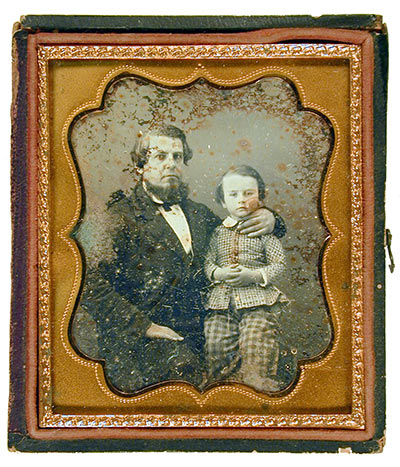I love Halloween and always have. When I volunteered to tackle a Halloween-themed blog post I originally wanted to explore death photography in the collection. While this cringe-worthy tradition has not completely died out (pun totally intended), it was an accepted form of remembrance for many Americans in the 19th century. Photographers would pose children who died as if they were sleeping, maybe surrounded by toys or flowers, and sometimes surrounded by living siblings or parents. Adults who passed away would often be posed as if they were sleeping. While incredibly creepy, these photographs might have been the only physical way for families to remember lost loved ones.

I went searching through boxes of daguerreotypes, tintypes, and ambrotypes for some of these morbid works of art and was struck by something completely different: Early photographs of children are spooky in general.
But what makes them so unsettling? Part of it is the wear of the objects themselves. Many early photographs don’t age particularly well because they were used. The cases were opened repeatedly, so they fray on the edges or break, and the metals on which the images were captured tarnish. Daguerreotypes were made on a silver-coated sheet of copper, so you can imagine what over 100 years of exposure can do. (These are all now wrapped in individual acid-free boxes inside a larger acid-free box to slow the wear, but time takes its toll on all things.)

The poses can also be off-putting. Exposure time for early photographs was extremely long, especially compared to today’s point and click cameras. Some sitters might have had to sit still for 15 minutes or longer, depending on the light and the photographer’s methods. That’s a lifetime for an adult to sit still, let alone a child. In the portrait of John Blake Washington and his son, William, the father props his son’s neck up with his arm. There were even chairs invented with neck braces and straps to hold the sitter still long enough.

Any movement in the photograph resulted in a ghostly blur around the subject. This also explains why people don’t smile in early photographs. Try holding a smile for 15 minutes and see how long you last (kids love attempting this on tours).

These images are so creepy because they are not at all like the pictures of children that we share and cherish today. We take hundreds of pictures of our kids (or in my case, my niece and nephew) almost on a daily basis while they’re at play and being goofy, doing the things that kids do best (which usually isn’t sitting still for any period of time). These portraits, even of living children, don’t have the same life that we have become accustomed too. For that, they will always send a slight chill down my back.

Happy Halloween!
—Becca Hiester, Curatorial Assistant, Gibbes Museum of Art
Published October 27, 2016
Top image: Unknown (two young girls), by unknown artist; daguerreotype; 3 ½ s 2 ½ inches; Gibbes Museum of Art
1980.006.0004

